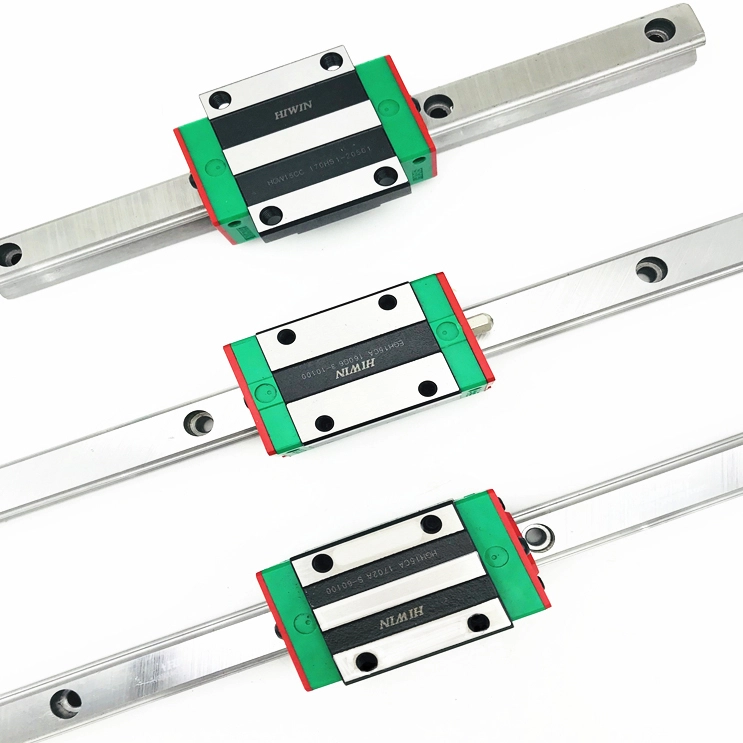Understanding Linear Guides
Linear guides, also known as line guides, slide rails, linear guide rails, and linear slide rails, are crucial components used in linear reciprocating motion applications. They offer a higher rated load capacity than linear bearings and can bear certain torque levels, ensuring high-precision linear motion under significant load conditions.
Functions and Types
The primary function of a linear motion guide rail is to support and guide moving parts, enabling reciprocating linear motion in a specified direction. Based on the type of friction, linear motion guides can be categorized into sliding friction guides, rolling friction guides, elastic friction guides, and fluid friction guides. Linear bearings, often used in conjunction with linear shafts, find applications in automated machinery such as German-imported machine tools, paper bowl machines, and laser welding machines. Linear guides are particularly favored in mechanical structures requiring high precision.
Design and Implementation
Linear guides convert motion from a curve to a straight line, allowing machine tools to achieve rapid feed rates even with consistent spindle speeds. These guides consist of two main components: a fixed element (guide) and a moving element. Being standard components, machine tool manufacturers need only to machine a plane for the mounting rail and adjust the rail's parallelism. To ensure accuracy, some scraping of the bed or column is often necessary, but the installation process is generally straightforward.
The guide rails, made of hardened steel and finely ground, feature complex cross-sectional geometries compared to flat guide rails. This complexity arises from the need to machine grooves on the rails to facilitate the movement of sliding elements. The shape and number of grooves depend on the specific function the machine is designed to perform. For instance, guide rail systems that handle both linear force and subversive moments differ significantly from those handling only linear force.
Operational Mechanics
In linear guides, rolling steel balls facilitate motion without any intermediate medium between the moving and fixed elements. These balls are ideal for high-speed motion due to their low friction coefficient and high sensitivity, meeting the operational needs of moving parts like machine tool rests and carriages. The fixed element of the linear guide system, akin to a bearing ring, serves as a bracket for the steel balls and typically has a "V" shape. A set of linear guides usually includes at least four brackets to support the machine tool's working parts, and for larger parts, more brackets might be required.
As the machine's beam moves, steel balls circulate within the bracket's grooves, distributing the beam's wear across all steel balls, thereby extending the linear guide's service life. To eliminate gaps between the beam and the guide rail, a preload can be applied. This preload is achieved by installing oversized steel balls between the guide rail and the beam. The steel balls, with a diameter tolerance of ±20 microns, are classified in increments of 0.5 microns before installation. The preload size depends on the force acting on the steel balls. If this force is too large, prolonged preloading increases the beam's movement resistance. Therefore, a balance is needed: reducing preload enhances system sensitivity and reduces movement resistance, while increasing preload improves movement accuracy and precision retention.
Maintenance and Durability
Over time, as the steel balls wear out, the preload weakens, reducing the beam's movement accuracy. To maintain original accuracy, the rail brackets or even the rails themselves may need replacement. If the rail system's preload has already been lost, replacing the rolling elements is the only way to restore accuracy.
Design Considerations
The design of the guide rail system aims to maximize the contact area between the fixed and moving elements, enhancing the system's bearing capacity and its ability to withstand impact forces from intermittent or gravity cutting. This broad distribution of force expands the bearing area. To achieve this, the grooves in the rail system are shaped to ensure maximum contact between the rolling steel balls and the guide rail.
Additional Points
-
Energy Efficiency: One significant advantage of linear guides is their contribution to energy efficiency in machinery. Due to the low friction coefficient of the rolling elements, less energy is required to move parts, reducing overall energy consumption and operational costs. This efficiency is particularly beneficial in large-scale industrial applications where even minor improvements in energy usage can lead to substantial cost savings.
-
Customization and Versatility: Linear guides offer a high degree of customization, allowing them to be tailored to specific applications and requirements. This versatility means they can be designed to meet particular load capacities, speeds, and environmental conditions, making them suitable for a wide range of industries, from manufacturing to medical devices. The ability to customize ensures optimal performance and longevity in diverse applications.
In summary, linear guides are essential for achieving precise linear motion in high-load applications. Their design, operational mechanics, and the ability to customize make them invaluable components in various industrial and technological fields.

